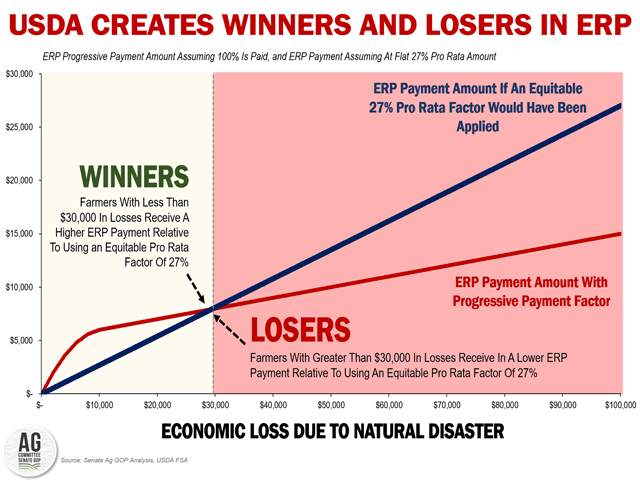Bipartisan Complaints Grow Over ERP
Democrats Join Republican Criticism of USDA's Emergency Relief Program Payment Formula
OMAHA (DTN) -- Congressional Democrats are joining their Republican colleagues in questioning how USDA is implementing the 2022 Emergency Relief Program.
Sen. Michael Bennet, D-Colo., and Sen. Jerry Moran, R-Kan., led a bipartisan letter from senators and House members to Agriculture Secretary Tom Vilsack challenging USDA's methodology for issuing payments under the Emergency Relief Program (ERP), which skews payments to provide a higher percentage of aid for smaller losses. Lawmakers asked USDA to "explain the economic justification" for how payments are being calculated.
Congress authorized $3.74 billion for disaster assistance to deal with more than $10 billion in projected losses not covered by crop insurance. FSA Administrator Zach Ducheneaux told DTN earlier this week that USDA's payment methodology provided larger payments to about 82% of the 210,000 producers who filed claims for 2022 ERP money.
Members of Congress and major commodity groups have elevated their complaints about how USDA plans to disperse the funds.
In their letter -- at least the fourth from lawmakers -- Bennet, Moran and others asked if the states with the largest disaster losses would also be the ones with the most payments. Lawmakers also wanted to know if there were leftover funds from previous disaster programs in 2020 and 2021 that could be used to help boost the 2022 ERP.
The seven senators and 11 House members also pointed out an additional payment factor of 75% -- a 25% reduction in all payments -- is not included in a program fact sheet posted on USDA's website.
Disaster aid recipients in 2020 and 2021 also got back their crop insurance premiums and fees. The 2022 ERP says, "a percentage of these reimbursements will only be made available to certain producers." Lawmakers want to know why USDA changed that policy on premium reimbursements.
In a separate letter, 12 Republican senators have written the Government Accountability Office (GAO) to examine how USDA created a new payment factor for disaster aid that disadvantages larger farmers with higher financial losses.
On Monday, 66 House Republicans wrote that producers will see their losses capped dramatically. "The current program does not provide needed assistance to full-time farm families that suffered the deepest losses, and in short, it misallocates limited but badly needed assistance."
P[L1] D[0x0] M[300x250] OOP[F] ADUNIT[] T[]
Lawmakers and farm groups have said USDA's methodology for payments wasn't used in any recent disaster programs. The payment factor "acts as a de facto payment limit," stated a blog by the Senate Agriculture Committee GOP staff.
USDA did not reply to a request for comment Wednesday afternoon.
PROGRESSIVE VS. PRORATED PAYMENTS
Under the ERP payouts, the first $2,000 of a disaster loss is covered 100%. It then phases down to 80% up to $4,000 and 60% for $6,000. Above $10,000 in losses, producers receive 10% of their payment losses. The payments are then prorated an additional 75%.
Essentially, a farmer with $2,000 in disaster losses could receive an initial $1,500 payment. A producer with $100,000 in losses would see 85% of their losses not covered. Those producers with the largest losses might only see an initial payment of $11,250.
Under a uniform factor, each producer receives a payment for the same percentage of their losses, which the Senate Ag GOP staff pegged at 27%.
At 25%, for instance, a farmer with a $2,000 loss receives a $540 payment, or $960 less. A farmer with a $100,000 loss receives a $27,000 payment, a $15,750 gain.
The GOP blog cited that farmers with losses under $30,000 receive higher ERP payments under USDA's progressive factor. Farmers with larger losses than $30,000 see their payments go down compared to having an equitable prorated payment.
REQUEST TO GAO
Sen. John Hoeven, R-N.D., the ranking member for the Appropriations Subcommittee for Agriculture, and Sen. John Boozman, R-Ark., the ranking member on the Agriculture Committee, led the letter to the GAO. They asked the agency to see if USDA has ever applied anything other than a "single uniform payment factor" when determining producer benefits. They also wanted to know if the progressive factor applies maximum benefits in an unbiased manner and is based on producer losses." And they also wanted to know whether USDA ever restricted benefits to farmers without specific statutory authority.
HOUSE AG CHAIR
Rep. Glenn "GT" Thompson, R-Penn., on Wednesday criticized the way USDA is implementing ERP as he made his defense for the way the crop insurance program is run.
Thompson questioned how groups could criticize crop insurers "amidst the ongoing debacle of USDA's implementation of disaster aid for 2022 losses. Government delivery of aid is the alternative to the public-private partnership, and I don't know of a single producer that would want to make that trade or a single taxpayer that would not ultimately regret upending the system we currently have."
While lawmakers ask for GAO investigations, Thompson also challenged a GAO report released Monday highlighting possible ways to cut crop insurance costs, saying the report "isn't worth the paper it is printed on."
For more, see "Disputes About Payment Factors for ERP Disaster Aid and Funding Shortage for PARP" here:
Also see "GAO: Cap Crop Insurers' Profits and Subsidies to Large Farmers" here: https://www.dtnpf.com/….
Chris Clayton can be reached at Chris.Clayton@dtn.com
Follow him on X, formerly known as Twitter, @ChrisClaytonDTN
(c) Copyright 2023 DTN, LLC. All rights reserved.



